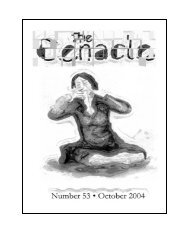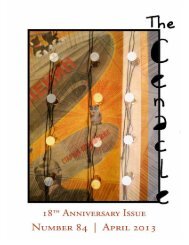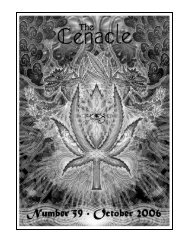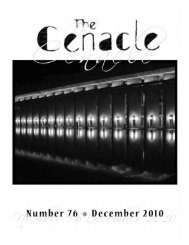Democrat, Illinois - The ElectroLounge
Democrat, Illinois - The ElectroLounge
Democrat, Illinois - The ElectroLounge
You also want an ePaper? Increase the reach of your titles
YUMPU automatically turns print PDFs into web optimized ePapers that Google loves.
2<br />
!<br />
Willendorf, a fat little prehistoric fertility figurine, called her “bulging, bulbous, bubbling . . .<br />
bent over her own belly . . . eternally pregnant. She broods, in all senses<br />
. . . swollen . . . weighed down by her inflated mounds of breast, belly, and buttock” (Sexual<br />
Personae, 1990, pp. 55-56).<br />
Paglia’s intuition got it exactly right: B is about swelling, inflation, bulges. In a<br />
paper 1 published the same year as Paglia’s book, the linguist John Lawler used very similar<br />
terms to gloss bl- words like blimp, bladder, bloat, and blister. <strong>The</strong>y represent “contained<br />
fluid,” he said, “(either liquid or gas) under pressure, with distinctive distension of its<br />
container, producing a natural roundness.” Plain b- represents it too, as in barrel, ball,<br />
balloon, billow, and Paglia’s “bulging, bulbous, bubbling.” And how do we make balloons and<br />
bubbles bulge? By blowing: we blow bubbles, blow up balloons.<br />
Blowing, you see, because B evokes “airiness” through mouth-pantomime. It’s an<br />
airy sound. Put your hand in front of your mouth and say “buh”—you’ll feel a very distinct<br />
puff of air that you can’t feel if you say “nuh” or “yuh” or most other consonants. I’m certain<br />
that the air-puff made by articulating the sound of B is why many languages, including our<br />
own, tend to use B words to name inflated, bulging things. And the written letter has<br />
evolved a bulging shape to reinforce the idea, a shape explicitly resembling the most bulbous<br />
part of the self-interested mammals who invented the alphabet: a nice round bottom.<br />
Big bottoms! Anything inflated seems big almost by definition. Samuel Johnson’s<br />
1755 dictionary partly defined big as “full of something . . . distended, swoln.” Big is one of<br />
the prime B words, one of the prime B ideas. When Jonathan Swift created a race of giants<br />
in Gulliver’s Travels (1726), he called them Brobdingnagians. <strong>The</strong> biggest dinosaur was a<br />
brontosaurus. <strong>The</strong> Bible mentions a huge animal called behemoth, thought to be the<br />
hippopotamus (Job 40:15). That’s Hebrew, but big animals tend to have B names in English<br />
also: bull, bear, buck, boar, buffalo, bison, bronco. Australians call big male kangaroos boomers,<br />
and elephants are known to circus people as bulls. I had an elephant named Babe as a child,<br />
and the big blue ox of the legendary lumberjack Paul Bunyan was named Babe too.<br />
Paul Bunyan was a giant himself, of course, and it’s very common for fictional B<br />
characters like him to be oversized. Watching TV one afternoon a few years ago, I suddenly<br />
noticed a fat cartoon lady called “Aunt Bertha,” and then a few minutes later in a different<br />
cartoon, a huge wrestler called “Lardo, the Belgian Behemoth.” I knew I was on to<br />
something. Eventually, though, it became clear that B’s “body” and “bottom” connection<br />
concerns “animality” as much as “size.” <strong>The</strong> bottom is the most prominent part of the body;<br />
and popular speech often equates it with the entire body: save your butt, get your butt over<br />
here. But it’s also the least civilized part of the body: part sexual lure, part outlet of the<br />
digestive system, the last stop of the unlovely process that begins with burps and winds<br />
through bellies and bowels. We can’t disown it, all that sexual and digestive stuff, but we can<br />
!!!!!!!!!!!!!!!!!!!!!!!!!!!!!!!!!!!!!!!!!!!!!!!!!!!!!!!!<br />
1 John Lawler, “Women, Men, and Bristly Things: <strong>The</strong> Phonosemantics of the BR- Assonance in English,”<br />
Michigan Working Papers in Linguistics, Winter 1990, reprinted 1992 in <strong>The</strong> Joy of Grammar: A Festschrift for James<br />
McCawley, ed. G. Larsen et al. (Philadelphia: J. Benjamins). For more on B, see Margaret Magnus’s book Gods of the<br />
Word: Archetypes in the Consonants (Kirksville, MO: Thomas Jefferson Univ. Press, 1999), especially the<br />
Introduction and pp. 52 and 87-93.<br />
!"#$%#&'()#$*$+,$*$-.&#$/001!<br />
!









